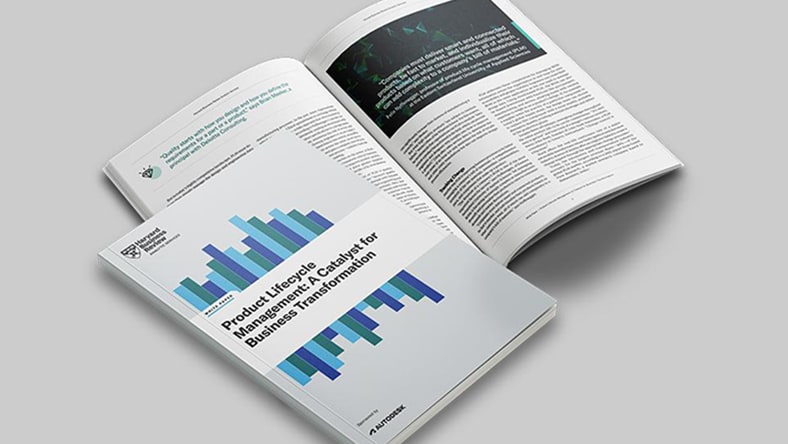& Construction

Integrated BIM tools, including Revit, AutoCAD, and Civil 3D
& Manufacturing

Professional CAD/CAM tools built on Inventor and AutoCAD
Before manufacturing. Before engineering. Even before design, there is the bill of materials. Manage it well and answer critical questions, like: “What do we make? What do we buy? What do we outsource?” Manage it poorly and face cost overruns or missed targets. In this on-demand webinar, we’ll show you how cloud PLM can help improve BOM management, bridging design, engineering, and manufacturing in a centralized system that saves you time and money.
Create different BOMs for different use cases—engineering, manufacturing, and more—to ensure the right data is always available to the right team.
Identify differences between BOM versions, or even types of BOMs, for a more complete and accurate view of product data, and better decision making.
Reduce the risk of manual data entry by connecting BOMs to your CAD files—the data updates automatically as the design changes.
Track changes, view previous versions, and revert changes with robust version control capabilities that ensure data integrity throughout the product development cycle.
Provide BOM access across your design, engineering, manufacturing, and procurement teams for improved collaboration, fewer errors, and higher productivity.
Eliminate confusion and improve data visibility by customizing BOM views for different users—so they only see what they need to see.
Deliver critical insights on materials throughout every stage of the product development lifecycle—from initial design to end of life.
Give all stakeholders input by allowing them to propose, validate, and modify BOMs, for a more efficient change management process.
Avoid costly mistakes by ensuring your supply chain has real-time access to the most up-to-date, structured BOMs for accuracy and regulatory compliance.
REPORT
Go beyond managing data to deliver visibility across the entire development process with cloud PLM.
COMMENTARY
Get research firm CIMdata’s expert perspective on bill of materials management with Autodesk PLM.
E-BOOK
Learn how to improve quality, reduce cost, and speed time to market with connected PDM-PLM workflows.
Bring PDM to your existing CAD workflows—to increase product development agility and minimize time on low- and no-value tasks.
Provide 24/7 access to quoting, procurement, and supplier management—to anticipate and react to supply chain issues with more agility.
Move your change management processes to the cloud—to help teams automate and document changes and revisions throughout every phase of your product lifecycle.
Close the loop on quality with cloud-based tools that help you improve product designs, identify supplier problems, and bring products to market more quickly.
Create configurable project templates and standardized phase-gate milestones, deliverables, and tasks— and accelerate the time from new product concept to production.
Keep everyone on the same page with a PLM solution that integrates with any CAD software—to help your teams work and collaborate more effectively.
The road to profitability starts by connecting your BOM management processes with Autodesk PLM. Talk to Sales about how BOM management throughout your product development cycle can drive big gains in agility, sustainability, and reliability.
A bill of materials (BOM) is a comprehensive list that outlines all the components, parts, and materials required to manufacture or assemble a product. It includes detailed specifications such as quantity, dimensions, part numbers, and descriptions. A BOM serves as a blueprint for production, providing a complete recipe of the product and its creation process. BOMs are crucial in supply chain collaboration, as they help in planning purchases, estimating costs, and maintaining inventory control. They also facilitate communication and coordination among different departments within an organization, such as design, procurement, and manufacturing.
The use of a bill of materials (BOM) offers numerous advantages in product manufacturing and management. Firstly, it provides a precise list of all components needed, reducing the risk of errors during production. It enhances communication and coordination among various teams, from design to procurement to manufacturing, fostering smooth workflow. BOMs also facilitate inventory control, helping businesses plan their purchases and manage stock efficiently. Additionally, they aid in cost estimation by accounting for all necessary materials and parts. In the scenario of product modifications, a BOM helps track changes, ensuring that all teams are working with updated information. Overall, a BOM contributes to increased productivity, cost-effectiveness, and product quality.
A bill of materials (BOM) in manufacturing is a comprehensive inventory of the raw materials, assemblies, sub-assemblies, parts, and components, along with their quantities, needed to manufacture a final product. It acts as a critical communication tool between the design and manufacturing teams, ensuring the correct materials are used at the right stages of production. The BOM can be single-level, showing the relationship between the final product and its immediate parts, or multi-level, detailing multiple sub-assemblies and their relationships. By providing a clear view of what's needed for production, a BOM helps streamline manufacturing processes, minimize production errors, and manage inventory more effectively.
Product lifecycle management (PLM) in the context of bill of materials (BOM) management is a systematic approach to managing all information about a product's components throughout its lifecycle. This includes design, manufacturing, end of life, and disposal stages. PLM software provides a central repository for BOMs, offering real-time updates, version control, and cross-departmental access. It enables teams to accurately track changes in product composition, material sourcing, and costs over time. This enhances efficiency, reduces errors, and ensures that all stakeholders have the most current information. In essence, PLM serves as an integral tool for BOM management, facilitating seamless product development and lifecycle management.
Yes, product lifecycle management (PLM) can significantly assist in maintaining different versions of a BOM throughout a product's lifecycle. As a product evolves from design to manufacturing to new product introduction, its BOM also changes. PLM provides a centralized system that allows for version control and tracking these changes in real-time. It can manage multiple BOM versions simultaneously, indicating what materials, parts, and components were used at each stage of the product's lifecycle. This ability to manage and monitor changes helps prevent confusion, improve communication across departments, and ensure that the manufacturing process aligns with the product's current design.
Using a product lifecycle management (PLM) solution, like Autodesk Fusion Manage, can play a key role in reducing errors in bills of materials (BOMs). It provides a unified, centralized system where all BOM information is stored and managed. This ensures that everyone involved in the product's lifecycle, from design to manufacturing, is working with the same, up-to-date information, thereby minimizing the risk of errors due to outdated or incorrect data. PLM also provides version control, enabling teams to track changes and revisions accurately. Additionally, by automating certain processes, PLM can reduce manual data entry, which is often a common source of errors. Using a PLM solution significantly enhances the accuracy and reliability of BOMs.
Yes, product lifecycle management (PLM) can facilitate better communication between different departments regarding bills of materials (BOMs). PLM serves as a centralized system for managing all BOM information, making it accessible to all relevant departments in real-time. This ensures everyone, from design and manufacturing to procurement and quality, works from the same, accurate data. It also enables seamless information flow and collaboration, ensuring changes to the BOM are communicated promptly and accurately. By providing centralized BOM information, PLM minimizes misunderstandings, reduces errors, and promotes efficient cross-functional teamwork, enhancing overall productivity and product quality.
Using a product lifecycle management solution, like Autodesk Fusion Manage for BOM management significantly enhances quality management in several ways. By providing a centralized system for product information, it ensures accuracy and consistency, which are crucial for quality control. It also allows for real-time tracking of changes in the BOM, enabling quick identification and correction of any issues, which helps prevent quality problems. PLM also promotes cross-functional collaboration for a holistic approach to quality management. Lastly, PLM's traceability features make it easier to comply with quality standards and regulations. Thus, PLM contributes to improved product quality, customer satisfaction, and overall business success.
Yes, a product lifecycle management system can integrate BOMs with other business processes such as Enterprise Resource Planning (ERP). This integration enables information to flow from the PLM system, where product design and BOM development occur, to the ERP system, which manages resources, procurement, and other business operations. Such a connection ensures that all departments are working with the same, up-to-date information, enhancing efficiency and reducing the risk of errors. It also enables real-time updates in the ERP system when changes are made in the BOM, facilitating accurate planning, procurement, and manufacturing processes.



